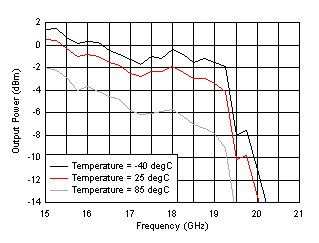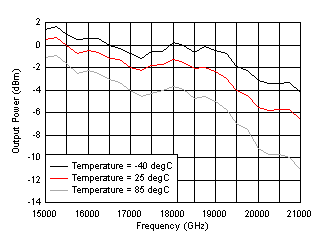ZHCSGL4C June 2017 – April 2019 LMX2595
PRODUCTION DATA.
- 1 特性
- 2 应用
- 3 说明
- 4 修订历史记录
- 5 Pin Configuration and Functions
- 6 Specifications
-
7 Detailed Description
- 7.1 Overview
- 7.2 Functional Block Diagram
- 7.3
Feature Description
- 7.3.1 Reference Oscillator Input
- 7.3.2 Reference Path
- 7.3.3 PLL Phase Detector and Charge Pump
- 7.3.4 N-Divider and Fractional Circuitry
- 7.3.5 MUXout Pin
- 7.3.6 VCO (Voltage-Controlled Oscillator)
- 7.3.7 Channel Divider
- 7.3.8 VCO Doubler
- 7.3.9 Output Buffer
- 7.3.10 Power-Down Modes
- 7.3.11 Phase Synchronization
- 7.3.12 Phase Adjust
- 7.3.13 Fine Adjustments for Phase Adjust and Phase SYNC
- 7.3.14 Ramping Function
- 7.3.15 SYSREF
- 7.3.16 SysRefReq Pin
- 7.4 Device Functional Modes
- 7.5 Programming
- 7.6
Register Maps
- 7.6.1 General Registers R0, R1, & R7
- 7.6.2 Input Path Registers
- 7.6.3 Charge Pump Registers (R13, R14)
- 7.6.4 VCO Calibration Registers
- 7.6.5 N Divider, MASH, and Output Registers
- 7.6.6 SYNC and SysRefReq Input Pin Register
- 7.6.7 Lock Detect Registers
- 7.6.8 MASH_RESET
- 7.6.9 SysREF Registers
- 7.6.10 CHANNEL Divider And VCO Doubler Registers
- 7.6.11 Ramping and Calibration Fields
- 7.6.12 Ramping Registers
- 7.6.13 Readback Registers
- 8 Application and Implementation
- 9 Power Supply Recommendations
- 10Layout
- 11器件和文档支持
- 12机械、封装和可订购信息
8.1.5 Performance Comparison Between 1572 (0x0624) and 3115 (0x0C2B) for Register DBLR_IBIAS_CTRL1 (R25[15:0])
There is a new setting for register DBLR_IBIAS_CTRL1 (R25[15:0]): from 1572 (0x0624) to 3115 (0x0C2B). The old setting can operate up to 19-GHz output, but the new setting can extend the frequency range to 20 GHz. The field name DBLR_IBIAS_CTRL1 is short for "Doubler Current Bias Control 1". It only impacts the doubler and does not affect the performance below 15 GHz. Shown in Figure 57 and Figure 58, with old R25 value, the output power and phase noise floor fall apart beyond 19 GHz. But with the new setting, they remain stable up to 20 GHz. Figure 59 and Figure 60 show that new R25 value leads to less output power variation with temperature at high frequencies. Figure 61 shows the improvement in half harmonic.
![LMX2595 Phase Noise Floor Across Frequency: DBLR_IBIAS_CTRL1 (R25[15:0]) Value Old vs New LMX2595 D032_SNAS696.gif](/ods/images/ZHCSGL4C/D032_SNAS696.gif)
| OUTA_PWR = 20 | Single-ended output |

| OUTA_PWR = 20 | Single-ended output |
![LMX2595 1/2 Harmonic Across Frequency: DBLR_IBIAS_CTRL1 (R25[15:0]) Value Old vs New LMX2595 D033_SNAS696.gif](/ods/images/ZHCSGL4C/D033_SNAS696.gif)
| OUTA_PWR = 20 | Single-ended output |
![LMX2595 Output Power Across Frequency: DBLR_IBIAS_CTRL1 (R25[15:0]) Value Old vs New LMX2595 D029_SNAS696.gif](/ods/images/ZHCSGL4C/D029_SNAS696.gif)
| OUTA_PWR = 20 | Single-ended output |

| OUTA_PWR = 20 | Single-ended output |